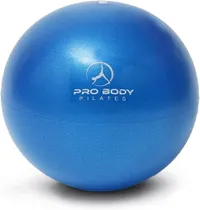I tried this routine that targets ‘belly pooch’ — here's what happened to my core
This workout targets more than just your abs

I’m a certified personal trainer who works with pre and post-natal clients, so I knew that my own pregnancy would compromise my abdominal strength. What I didn’t realize is how much my glutes, hips, and thighs would weaken, too. Even though I was lucky enough to continue training up until the day I gave birth, I was shocked at how much strength I had lost in these areas once I began exercising again postpartum.
I’ve been focusing on the basics for a while now, and while that’s done wonders to help me regain my strength, doing the same moves every workout has gotten a bit easy. Looking to Instagram for some variety, I found Pilates trainer and Belle Method creator Nikki Bergen’s routine for low diastasis recti and “belly pooch.” It looked like the kind of challenge I was after, so I rolled out my yoga mat and gave it a go.
What is Diastasis Recti?
“Diastasis Recti is a common condition resulting from pregnancy,” says Carrie A. Lamb, DPT, PT, OCS, a Physical Therapist with Connect Physical Therapy in Golden, Colorado. “It is the result of natural stretching of the rectus abdominis to accommodate a growing uterus.”
While Diastasis Recti happens frequently during gestation, it often lingers after childbirth. “In some women, the tissue recoils and heals after childbirth, and in some it persists,” Lamb continued. “Just like a rubber band can lose its elasticity over time, the linea alba can also lose its stretchiness. It will show up as a “pooch” just above or just below the belly button.”

Carrie A. Lamb (PT, DPT, OCS) is a Physical Therapist and Certified Pilates Trainer with Connect Physical Therapy in Golden, Colorado. Carrie is passionate about empowering people to optimize their movement and fully engage with the world around them.
How to do Nikki Bergen’s “belly pooch” workout
A post shared by Nikki Bergen PILATES + PELVIC HEALTH (@thebellemethod)
A photo posted by on
In addition to a yoga mat, you’ll need a looped resistance band and a pilates ball.
This Pilates ball is currently on sale for less than ten bucks, and will up the intensity of your Pilates workouts, forcing your core to work harder as you balance on the ball.
There are 5 moves in this routine, which are:
- Inverted straight leg pull-ins
- Propped foot marches
- Table press outs
- Frog press outs
- Resisted table press outs
Bergen doesn’t mention how many reps or sets of the exercises to do, so I decided to do 10 reps for 3 sets in a circuit format.
Get instant access to breaking news, the hottest reviews, great deals and helpful tips.
“These 5 exercises are fantastic for improving tension in your abdominal wall at and below the navel (lower diastasis),” Bergen says in the workout’s caption. Since I’ve been healing from a minor case of lower diastasis, I was eager to start working on these moves. Here are my thoughts:
1. It was harder than it looked
Before pregnancy, I taught a weekly barre class, and I’d always hear the same observations from my students: “This looked so easy, but it left me shaking!”
Such was the case with this routine. Even though I knew the exercises would probably be challenging for me, I didn’t realize just how much deep core strength and stability I would need to make it through. I was definitely shaking on a few of the exercises, but since Bergen was too, I didn’t feel so behind.
I would have never been able to make it through these exercises without 4 months of pelvic floor therapy first, where I built back my strength doing basic deep core moves like diaphragmatic breathing and heel slides. Despite the difficulty, it was nice to see how far I’ve come.
If you’re recently postpartum, save this routine until you’ve regained at least some of your core strength.
2. My glutes and thighs felt the burn
I’ll never forget the day when, about eight months pregnant, I looked in the mirror and wondered where exactly my glutes had gone! It was a surprising observation and one that I wasn’t entirely prepared for, so a lot of my postpartum recovery has focused on rebuilding my glute strength.
The last three exercises in this routine — the table press outs, frog press outs, and resisted table press outs — set my glutes and thighs on fire. In fact, I needed to pause halfway through my second set of frog press outs to avoid bad form. By the third set, my range had decreased, and I struggled to make it to the end.
Again, I wouldn’t have been able to do these moves unless I had focused on re-mastering the basics, like glute bridges and lateral walks, first. Make sure you can do those correctly and without too much fatigue before attempting this workout.
3. My lower back started to ache
I’ve had lower back issues since my teens, and I was more than a little nervous about pregnancy making them worse. While I didn’t experience any severe flare-ups (thank goodness), the area is still tight and achy.
Core work has always been somewhat challenging in that regard, as certain movements or positions will aggravate my already-cranky back. This happened on a few exercises, namely the inverted straight leg pull-ins and propped foot marches. I modified by adjusting the ball to a position that felt more comfortable, and I took breaks after each movement to stretch a bit before moving on.
Those who are postpartum can be especially susceptible to low back pain and weakness, so don’t be afraid to take breaks or modify the exercises if needed.
4. I felt my abs and glutes the next day
Soreness doesn’t indicate a “good” workout, but I have to admit that it was actually kind of nice to feel sore in my abdominals and glutes the next day. I’d gone a year without that day-after fatigue, and it was strangely rewarding to know that I had challenged these muscle groups in a new, more intense way. The soreness didn’t impact my normal routine, so that was an indication that I had worked at an appropriate level.
That being said, I don’t recommend chasing any post-workout soreness. That goes double for anyone who’s recently had a baby. Proper progression and patience are key to rebuilding your pre-pregnancy strength levels.
Follow Tom's Guide on Google News, or add us as a preferred source, to get our up-to-date news, analysis, and reviews in your feeds. Make sure to click the Follow button!
More from Tom's Guide
- Over 60? I’m a personal trainer, and these 3 floor exercises will show you how strong your core is
- I swapped running for 'Jeffing' for a week — and now I'm hooked
- Stiff hips? Personal trainer says this is the one exercise you should do to unstick them and boost flexibility

Jennifer Rizzuto is a freelance writer and certified personal trainer based in Long Island, NY. She covers various fitness-related topics and reviews for Tom's Guide. She also writes sketch comedy and short films, and performs frequently as an actor, singer, and improviser. When she's not writing, working out, or performing, you'll find her trying to convince her husband to get a dog.
You must confirm your public display name before commenting
Please logout and then login again, you will then be prompted to enter your display name.

